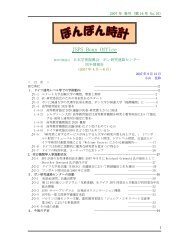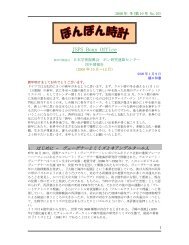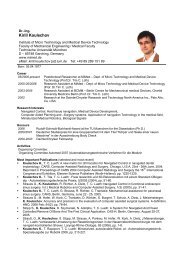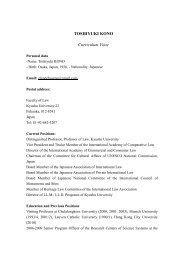Tomoaki Nishiyama - JSPS
Tomoaki Nishiyama - JSPS
Tomoaki Nishiyama - JSPS
You also want an ePaper? Increase the reach of your titles
YUMPU automatically turns print PDFs into web optimized ePapers that Google loves.
Dr.<br />
<strong>Tomoaki</strong> <strong>Nishiyama</strong><br />
Division of Functional Genomics,<br />
Advanced Science Research Center,<br />
Kanazawa University,<br />
Takaramachi 13-1, Kanazawa 920-0934, Japan<br />
Tel: +81-76-265-2776 Fax: +81-76-234-4537<br />
E-mail: tomoakin [at] kenroku.kanazawa-u.ac.jp<br />
_________________________________________________________________________<br />
Evolution of developmental regulatory system in plants based on large scale<br />
phylogenetic analyses utilizing whole genome shotgun sequence data<br />
A comparison of eumetazoan genomes revealed that their common ancestor had<br />
complex sets of genes similar to those used in extant bilateral metazoan development.<br />
In contrast, the evolution of developmental genes in another major lineage of<br />
multicellular land organisms, the land plants, has remained a mystery due to a lack of<br />
genomic data for non-flowering plants. By incorporating the accumulated genomic<br />
sequence data for the lycopod Selaginella moellendorffii and the moss Physcomitrella<br />
patens, we analysed the phylogenetic relationships of homologues of 826 Arabidopsis<br />
thaliana genes that function in development and identified putative orthologues to each<br />
gene. Here we show that S. moellendorffii and P. patens retain 88% and 86% of<br />
putative orthologues, respectively, including those involved in flowering plant specific<br />
development. Eighty-one percent of putative orthologues was shared in all the land<br />
plants. However, we also found flowering plant and vascular plant specific putative<br />
orthologues. Furthermore, lineage-specific expansions and contractions especially in<br />
cytoskeleton-, epigenetic gene regulation-, light signalling-, and phytohormone-related<br />
gene families were conspicuous. These data suggest that divergence in the number of<br />
putative orthologues amongst various land plant lineages contributed to the<br />
divergence of development in land plants.<br />
Trees and alignments are available through http://moss.nibb.ac.jp/treedb and the<br />
discussion can be found at http://wiki.genomics.purdue.edu/index.php/Selaginella<br />
CV<br />
Education: 1991-1995, The University of Tokyo, Japan<br />
PhD thesis: 1995-2000, Graduate School of Science, The University of Tokyo, Japan<br />
(Biological Sciences)<br />
Postdoc: 2000-2005, National Institute for Basic biology<br />
Assistant Professor: 2005- Kanazawa University<br />
Group Leader: 2006- Informatics Evolution group, ERATO HASEBE Reprogramming<br />
Evolution project, Japan Science and Technology Agency
Selected publication<br />
Sakakibara K, <strong>Nishiyama</strong> T, Deguchi H, Hasebe M. (2008)<br />
Class 1 KNOX genes are not involved in shoot development in the moss Physcomitrella patens<br />
but do function in sporophyte development.<br />
Evol Dev. 10:555-566<br />
T. <strong>Nishiyama</strong>, et al. (2004) Chloroplast Phylogeny Indicates that Bryophytes are Monophyletic.<br />
Mol. Biol. Evol. 21:1813-1819<br />
T. <strong>Nishiyama</strong>, et al. (2003) Comparative genomics of Physcomitrella patens gametophytic<br />
transcriptome and Arabidopsis thaliana: implication for land plant evolution. Proc. Natl. Acad.<br />
Sci. USA 100: 8007-8012<br />
T. <strong>Nishiyama</strong>, et al. (2000) Tagged Mutagenesis and Gene-trap in the Moss, Physcomitrella<br />
patens by Shuttle Mutagenesis. DNA Res. 7: 9-17
















